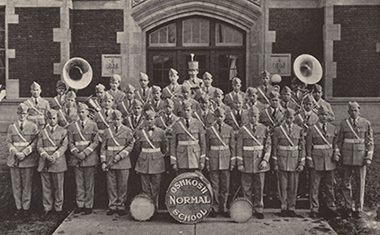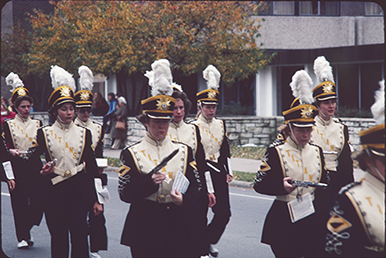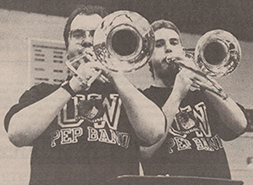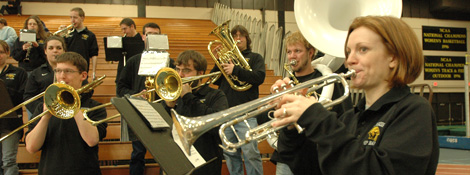Marching Band
Early Marching/Pep Band
While bands and orchestras had been organized on campus since the 19th century, a more lasting marching band was formed in September 1922. Chemistry instructor J.O. Frank is believed to be the first to offer course-credit for performing in a marching band according to the 1923 Quiver yearbook. And it may have been the addition of the credits that provided the stability needed for the band. Still, the school provided little in terms of instruments and sheet music, but the group achieved 30 students and community members that year. Only men appeared to be involved in the band at this time, although women played in the orchestra.
The 1925 Quiver provides the first indication that, now under the direction of music department head James A. Breese, participants were playing popular songs at football games, basketball games and pep rallies. The band received marching uniforms in 1926. The 1927 Quiver stated that "this organization became a recognized necessity for all city celebrations and athletic games."
The band purchased new uniforms again in 1938.
WWII
Quiver yearbooks show the band's makeup and functions were impacted by the United States' entry into World War II. Whereas just 20 years earlier the band only consisted of men, during the 1942-1943 academic year two-thirds of the band's 32 members were women due to the men going off to war. The 1943-1944 band had 18 women and no men. The 1944-1945 band had 15 women and one man.
The band continued to perform at athletic events and pep rallies through the 1942-1943 academic year. The following two years the men's athletic teams went on hiatus due to most of the male students enlisting in the war efforts. Without athletic events to perform at, it is unknown whether the women marched as a band. Men's athletics returned for the 1945-1946 academic year, and the Quiver indicates that the band played at every men's football game.
Men returned to the band during the 1945-1946 school year and made up about one-third of the 29-member group. The 1946-1947 academic year saw more men joining and membership jumping to 46 students, indicating a rebound after World War II.
The Marching Titans
In the fall of 1962, then-new band director Thomas Neice started the Marching Titans, which was a side commitment for Oshkosh State College musicians who were already part of the school concert band. Total enrollment in OSC's band program had jumped from 70 during the 1961-1962 academic year to a record 110 students during the 1962-1963 academic year, according to the September 15, 1962 Oshkosh Northwestern article titled "College Band to Perform On Sept. 22." To prepare for the 1962-1963 school year, the OSC music program purchased new band uniforms and sousaphones, French horns and marching drums. Initially just 72 students were allowed to march because there were not enough uniforms for everyone, but by November the band received the remainder of its uniforms and utilized all the musicians in marching settings.
The Marching Titans were active in their first year. They performed at parades, home football games and pep rallies. They often performed with the OSC Titanettes, an eight-woman poms and dance team that debuted at the 1962 Homecoming halftime show. The Marching Titans hosted a high school band day where they performed with 475 high-school students from seven Wisconsin schools at the September 22 home football game, according to the September 20 Northwestern article "Seven Area Bands to Play at Saturday Football Game." The band also performed a Thanksgiving-themed halftime show with the Titanettes at the November 18, 1962 Green Bay Packers home football game. The game and halftime show were televised nationwide on CBS.
During the 1963-1964 school year the marching band continued to play as one unit but divided into two concert bands in the off-season. The marching band played in football games, parades, pep rallies and public performances through the 1960s and 1970s. The music program was popular enough that the university added a third band around 1970.
At some point in the 1960s or 1970s the name Marching Titans became less used. Perhaps the marching unit stopped using that name and became informally referred to as the marching band.
Marching Discontinued
In 1980, the two university bands discontinued the marching side of their operations, but they still performed in concert hall settings and continue to do so today. Photographic evidence exists of UW Oshkosh students marching on campus as late as fall 1980, but the band scaled back its appearances that year. Advance-Titan sports editor Greg Ives wrote in the January 31, 1980 and February 14, 1980 newspapers that the pep band had not been present at the season's men's basketball games, and attendees would have more fun if the band would return.
In December 1980 the Music Student Council asked the Oshkosh Student Association Senate for money to reinstate the marching band, but their appeal was rejected because allocations committee chairman Tom Long didn't see a marching band as a priority for the student body, according to the December 4, 1980 Advance-Titan.
After the marching band dissolved, the university brought UW Madison's marching band to perform at Titan Booster Club fundraisers during the 1980s and 1990s. At football games, visiting groups such as the UW LaCrosse Marching Chiefs Band and the Whitnall High School marching band from Greenfield performed during halftime shows. Former Chancellor Edward Penson said in the November 14, 1985 Advance-Titan that a marching band would make UW Oshkosh a "'rah rah' school," and its students are spirited and actively involved without one. The September 22, 1988 Advance-Titan printed a student's call into The Gripe Line complaining about the university's absence of a marching band.
Pep Band
Advance-Titan newspapers show that the university had pep bands at sporting events throughout the 1980s and 1990s to fill the void left by the discontinuation of the marching band. It is unknown whether the band performed continuously for two decades or if there were lapses in between. The band likely dissolved in the late 1990s or early 2000s due to lack of funds and student interest. Questioning the existence of a UW Oshkosh pep band in 2002, former Advance-Titan sports editor Andrew Wagner asked his readers in a February 27, 2002 column, "Why did the University allocate $1,900 to the Pep Band? Has anybody SEEN the Pep Band? Does anybody PLAY in this Pep Band? Where the heck IS this Pep Band when a Pep Band is required?"
A resurgence in student interest led to the music department and music students restarting the pep band in 2007. The band lasted about four years. The band was a student-run organization funded by the athletic department. It did not march, but it performed at home men's and women's football and basketball games from the bleachers. The pep band performed the "Hail Titans" school song and pop songs from the 1950s through 2000s. A typical football or basketball game drew 15-25 instrumentalists, but pep band performances were occasionally cancelled due to low turnout.
The pep band disbanded sometime during the 2010-2011 school year, with possible reasons being funding issues, low student participation, and athletes preferring prerecorded music over a live band. The university and the pep band collaborated to film a "Hail Titans" music video in 2010 that is still online.
The university has not had a pep band since the late-2000s band ended.
Photos

The band at Oshkosh Normal School band in 1923.

The band wearing its new uniforms received in 1927.

The Marching Titans form a Pilgrim hat during the halftime show of the Green Bay Packers vs. Baltimore Colts football game on November 18, 1962.

One of the last photographs of the UW Oshkosh marching band, fall 1980.

Advance-Titan photo of Trent Brown and Tim Smith playing trombones at the February 6, 1990 Titan men's basketball game. Their t-shirts say "UW Oshkosh Pep Band" with the circular UW Oshkosh logo in the center of the "UW."

The UW Oshkosh Pep Band performs on January 26, 2008 at a men's basketball game against UW Stevens Point.

